
7 minute read
ANZAC II: Walers and a ‘Chloe’ sequel
OPUS LXXVI
I had an ANZAC Day experience this year in my efforts to get a photograph of Chloe used in the previous issue of Surgical News. I even asked one of the servicemen to walk by the portrait so discretion would obtain. The ANZAC spirit still pervaded the first-floor bar and I was even offered a beer by a stranger (did I look like one of the old brigades?). How does the word Waler come into this title? My habit of asking every patient in this medico-legal phase of my career their occupation—‘I am a Waler’ surfaced once and my mind went straight to the 1850s novel Moby Dick by Herman Melville, about the albino whale and Captain Ahab who went hunting for the big white brute, the size of his sailing ship. Walers were the brumby horses from western New South Wales, the breed favoured by the Australian Light Horse Regiment in WWI. They would have been part of that contingent of 120,000 horses sent to the Arabian Peninsula. These Walers had stamina, endurance and could work all day, ‘even without a drop to drink’. Their characteristic resilience in the desert was the hallmark of their success.
Advertisement
Actual Beersheba image In the Battle of Beersheba, these characteristics were their saving grace—carrying heavy weapons, guns and ammunition, and military supplies, weaving their way in and out of the Turkish trenches, eventually capturing the regiment, then arriving at Damascus on the way to Jerusalem. Later that day Lawrence of Arabia in his Rolls Royce (illustrated) claimed it as a British victory. Incidentally, John Hanrahan, a former president of the College in the 90s, when hearing of this article would enlighten me that it was an ANZAC dentist who was the first man to set foot in Damascus. Thanks to this tip I discovered an article in the Sydney Morning Herald that the person was lieutenant-colonel Olden, who hailed from Ballarat. Most of the Walers had to be left behind as the cost of transport and quarantine precluded their return to Australia. Some ended up with the British forces in Egypt and India. Some of the soldiers in WWI could not handle the thought of losing their best friend in a foreign land and had to resort to euthanasia—one of the saddest days in their lives they said. Being killed in a war is incidental because that is where the story stops. Major Bridges had a horse, Sandy, and was the only Waler to return to Australia. A sculpture of the horse’s head, acknowledging the Walers, is on display at the Australian War Memorial.
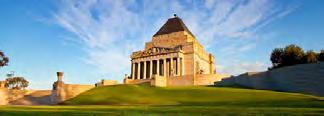
The Shrine of Remembrance – Melbourne Here is another ANZAC recollection piece from the Shrine of Remembrance in St Kilda Road. The building was designed by architects Philip Hudson and James Wardrop in the classical style of the mausoleum tomb of Halicarnassus and the Parthenon. Etched in marble there are the words ‘Greater Love Hath no Man’ (John 15:13). Every year on 11 November at 11am (Remembrance Day), a ray of sunlight is designed to shine through an aperture in the roof to highlight the word Love.
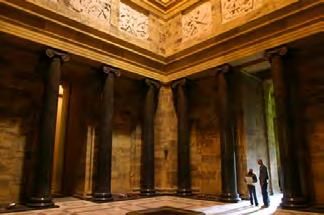
The sanctuary in the Shrine of Rememberance Lodge Bros, the construction engineers and their foreman of works—a returned veteran—was my patient at The Western Hospital, suffering from multiple skin cancers. After umpteen admissions he was grateful for the work done by the plastic and reconstructive team, so much so that one day on the ward round he offered me a little token of gratitude. “Felix, I have a present for you,” he said. “You can have my marquette of the Shrine.” A marquette is a miniature replica of a major construction. Not to seem too intrusive in accepting such a gift and being a little tardy in following up this gesture, the family overruled the patient’s wishes and I lost out. I had intended to give it to the College as a memento for the likes of Weary Dunlop and Bertie Coates for their wartime contribution. Even Bertie Coates later said, “memories of times past are our most treasured possessions,” as I keep trying to recall. Now let us dive back to T.E. Lawrence and his Welsh background. Historically, a life story emerged recently on one of those David Portillo train excursions into Wales on SBS Great British Rail Journeys. Lawrence was the unplanned son of Sir Thomas Chapman, an Anglo-Irish baronet, and his housemaid—born at Snowden Lodge in Wales.
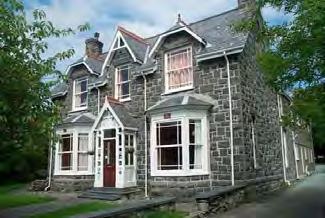
Snowden Lodge Saint Thomas More’s quip in Bolt’s play A Man for all Seasons stated, ‘It profit a man nothing to give his soul for the whole world ... but for Wales!’ But Wales played an important part in WWII in protecting the National Gallery collection when bombs were peppering the Trafalgar Square. Sir Kenneth Clark was the director of the National Gallery then and avoided sending the collection to Canada because of the German submarines in the North Sea. The collection was housed in the slate mines of Wales, offering protection for the Titians and Tintorettos etc.—all revealed in the train story. Lawrence’s Oxford days reflected his endurance and independence, refusing to attend lectures—‘I can write better than this’, he once said. Eventually his superiors compromised, and he graduated and went on an archaeological sabbatical to Syria spending four years there. The Bedouin link in his story are reflected in the film Lawrence of Arabia based on his book Seven Pillars of Wisdom. Incidentally, I bought a copy, a collector’s edition, for $5 at the Brotherhood of St Lawrence recently, which stimulated me to write this article.
Lawrence recounts his role as advisor to the Bedouin forces against the Ottoman Empire of 1916 – 1918 before being accepted back by the British Army. Yes, he always wore the Arab gear, which was incidentally not a standard British uniform issue. British history records it was Lawrence who captured Jerusalem after the Battle of Beersheba, driving up in a Rolls Royce (illustrated), unaware of the earlier ANZAC victory. Didn’t Churchill say, ‘Those who write history own it,’ but someone subsequently said, ‘Accurate historical recollections become the province of later generations’.
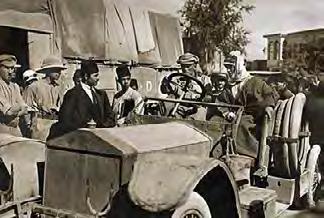
T.E. Lawrence arriving in his Rolls Royce after the fall of Beersheba After the war, Lawrence’s quest for speed was evident, even designing speed boats. These were subsequently used to rescue English and allied pilots from the Channel in the Battle of Britain. It was McIndoe who observed the value of the saline solution—from dunking in the Channel—in burns management to improve outcome, now a standard clinical practice. Lawrence’s insatiable desire for speed was his undoing. He bought a Brough Superior motorcycle, capable of 100mph in the early 1930s. Once skirting through the hedgerows of Surrey he tried to avoid crashing into a group of children on a school excursion, and went down an embankment and suffered a major head injury that was eventually fatal. It was managed at the new department of neurosurgery at the University of Oxford, founded by a South Australian surgeon called Sir William Hugh Cairns, as Damien Jensen revealed to me.
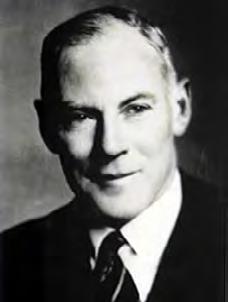
Sir William Hugh Cairns of Scottish descent and serving in the armed forces in WWI Even General S. Patton, with his ivory handled pistols on his hips, was admitted to the same unit following a crash in his jeep outside Paris. He eventually died. Damien’s awareness of head injuries ordained that he wore a motorcycle helmet when driving his two-door coupé. He could also recall that neurosurgery lives on the value of ancestor worship quoting the late Keith Henderson merely following the leader. At St Vincent’s Hospital, for example, Francis Morgan trained Keith Henderson who trained Damien in neurosurgery, all under the Cushing umbrella (where Adson’s forceps come from, used in every plastic surgical procedure). Some little pearls that surfaced like tea leaves in the tearoom at The West between cases— thank you Damien. My recent publication on Chloe created interest. Touchingly, we revealed how these past veterans sent correspondence home to their Melbourne ‘girlfriend’ eventually to be forwarded to their families. What a consolation on the home front from the desolation of the Somme, thanks to a beautiful Parisian artist’s model.
In a recent Napoleonic documentary, the words Lest we Forget, surfaced and I thought this was an ANZACISM—there is nothing new under the sun. And to hear the French President Macron—when entertaining our Prime Minister Albanese recently at the Elysée Palace—say, “We can never forget the debt France owes to the Australian forces in WWI including the Battles of the Somme and Fromelles.” (Thanks to the SBS French news) And to quote a little bit of history from Lawrence Binyon in his poem For the Fallen: ‘Age shall not weary them, nor the years condemn’.
We will remember them.
Associate Professor Felix Behan










